A Comprehensive Study of Diverse Bat Species
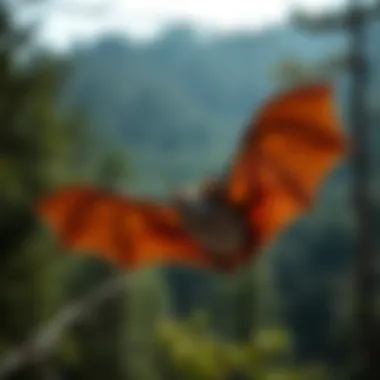
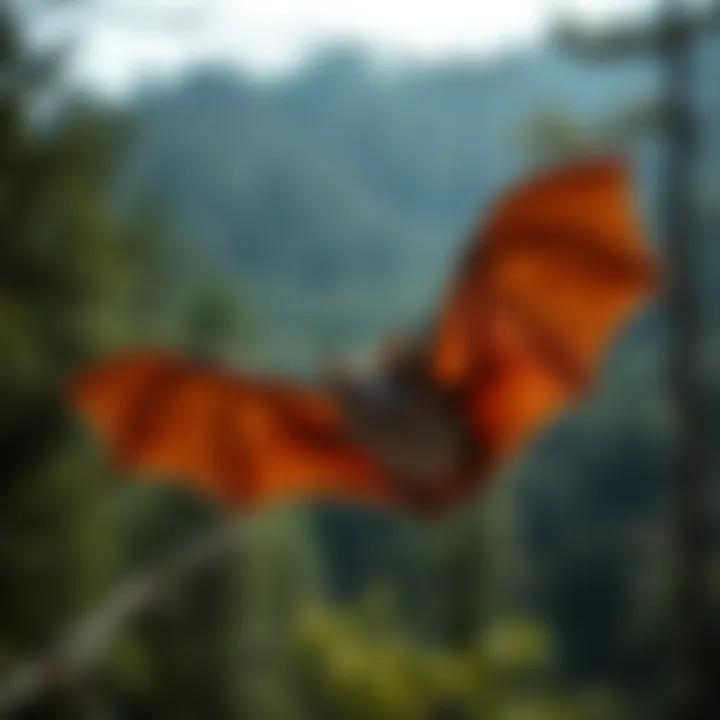
Intro
The world of bats is a fascinating tapestry woven from a multitude of threads, each representing a different species with its unique traits and behaviors. Bats, belonging to the order Chiroptera, are not merely flying mammals; they play crucial roles in ecosystems. Understanding the intricate details of their lives—from their feeding habits to their mating rituals—is essential for recognizing their impacts on the environment.
Bats thrive in various habitats, exhibiting remarkable adaptability. From the tropics to temperate regions, each species finds ways to survive and flourish in its specific environment. This article aims to delve deep into the diverse types of bats, their ecological significance, and the conservation activities necessary to protect them from the numerous threats they face today.
As we embark on this exploration, let's start with an examination of the understanding of forestry practices, which can significantly impact bat populations and their habitats.
Understanding Bat Biodiversity
Bat biodiversity plays a significant role in the complex web of life, not just because bats are fascinating creatures, but also due to their functional contributions to ecosystems. By examining the diversity found within the order Chiroptera, we gather insightful perspectives on how these flying mammals adapt to their environments and influence ecological balance. Understanding bat biodiversity is crucial for three main reasons: promoting conservation efforts, sustaining agriculture through pest control, and enhancing pollination processes in various ecosystems.
Classification of Bat Species
Biodiversity within Chiroptera
The order Chiroptera, which includes thousands of bat species, showcases a profound level of biodiversity. This rich variety contributes substantially to our understanding of ecological interactions and evolution. Each species exhibits unique traits, from size and color to behavior and reproductive strategies. For instance, the tiny bumblebee bat, weighing less than a penny, holds the title of the world’s smallest mammal, emphasizing the drastic differences found within this order.
One prominent characteristic of bat biodiversity is its ecological roles. Bats aid in pest control—some species can consume up to a thousand insects in a single night. This makes them invaluable allies for farmers and gardeners, reducing the need for chemical pesticides. The intricate behaviors accompanying their feeding patterns highlight their adaptive strategies in different environments, adding depth to the study of ecology.
However, this diversity does bring challenges. Many species are threatened by habitat destruction and climate change, causing serious gaps in our ecosystems that can lead to issues like decreased pest control and failing pollination rates.
Major Families of Bats
Within the Chiroptera order, there are several major families, including Phyllostomidae (leaf-nosed bats) and Vespertilionidae (evening bats). These families share common characteristics, such as echolocation, but they vary significantly in their diets and habitats. The family Phyllostomidae, for instance, has fruit-eating species that play a vital part in seed dispersal, whereas Vespertilionidae members primarily feed on insects.
The unique features of these families and their diverse diets make them a compelling topic for this article. For example, the dietary flexibility observed in many bat families enables them to thrive in various environments, but it also makes them vulnerable to ecological changes. As these bats forage for food, their decline can herald disturbances that affect other wildlife.
Global Distribution of Bats
Geographic Range
Bats are found on every continent except Antarctica, which lends to a broad geographic range examination. Understanding where different species exist gives us insight into their ecological niches and the habitats they're adapted to. Notably, tropical regions offer a higher diversity due to favorable climatic conditions and abundant food sources.
A key characteristic of bat distribution is their migratory behavior. Some bat species travel hundreds of miles in search of warmer climates or ample food supplies, reflecting their adaptability and resilience. However, reliance on specific migratory patterns can render them exposed to habitat loss, creating gaps in their traditional routes and threatening their survival.
Preferred Habitats
Bats thrive in various habitats, including forests, caves, urban areas, and wetlands. These distinct preferences shape their behavior and interactions within ecosystems. Forested areas, for instance, provide vital roosting sites and food sources, while urban habitats introduce unique challenges and advantages.
Understanding the preferred habitats of bats allows conservationists to target efforts more effectively, monitoring changes as human activities encroach on these spaces. This connection to their habitat highlights the intricate relationship bats have with their environments, showcasing the necessity of their preservation.
"Bats serve as a barometer for the health of our ecosystems; their declines often signal deeper environmental issues that need addressing."
The ecological consequences of losing bat species can be far-reaching, affecting species diversity, crop yields, and even the health of forests. As such, exploring bat biodiversity not only enriches our understanding of wildlife but is crucial for fostering a thriving planet.
Ecological Importance of Bats
Bats, often overlooked in discussions about wildlife diversity, play a pivotal role in maintaining environmental balance. Their contributions stretch beyond mere presence; they are key players in pollination, seed dispersal, and population control of insects. Understanding their ecological importance helps illuminate the complex interplay of species within ecosystems and highlights the reasons for their conservation.
Pollination Mechanics
Bats are among the unsung heroes of pollination, particularly in tropical and subtropical regions. Unlike bees, bats carry out nocturnal pollination, visiting flowers specifically adapted to their feeding behaviors. One striking example is the Agave plant, whose blossoms remain open at night and are often visited by the long-nosed bat. These bats, seeking nectar, inadvertently transfer pollen from one flower to another, enhancing genetic diversity and encouraging plant reproduction.
Notably, in areas with a healthy bat population, ecosystem productivity can be significantly higher. This is because bat-pollinated plants often form the backbone of their habitats, supporting various other species. The absence of bats could result in diminished plant reproduction, affecting everything from food supplies to local fauna.
Seed Dispersal Contributions
Bats also act as nature's gardeners, playing a vital role in seed dispersal. Several bat species, such as fruit bats, consume a variety of fruits and in the process transport seeds over considerable distances. When they excrete the seeds, the chances of those seeds taking root in new, fertile areas increase significantly.
This process is particularly crucial for forest regeneration. Many trees rely exclusively on bats for seed dispersal, and without them, these trees may struggle to repopulate disturbed or deforested areas. The interaction between bats and plants not only aids in plant vitality but also contributes to the overall health of forest ecosystems. A landscape alive with bats is typically more diverse and resilient.
Insect Population Control
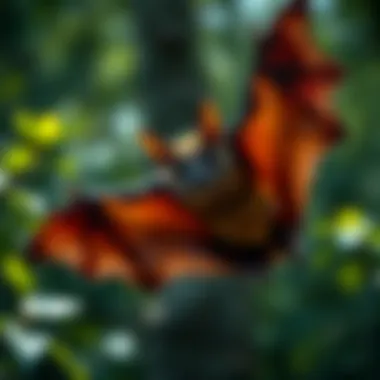
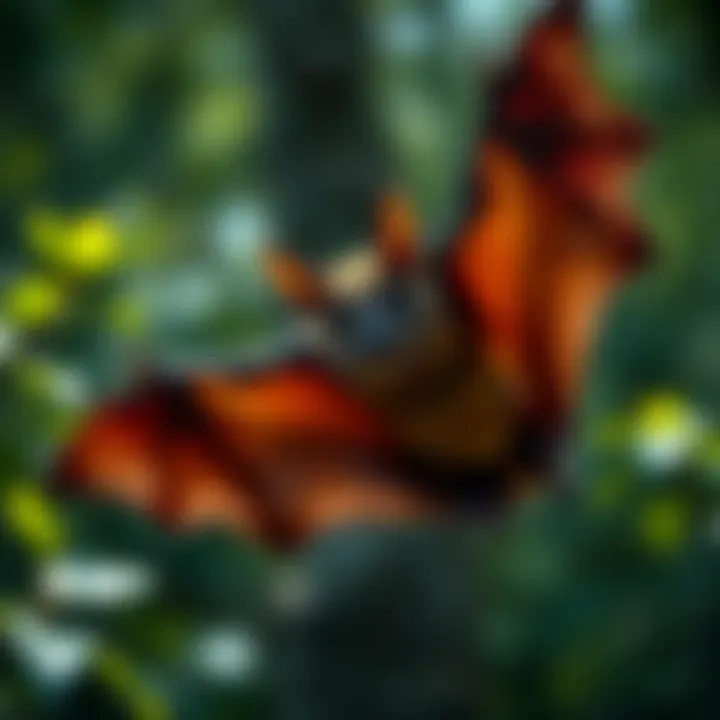
One cannot discuss bat ecology without acknowledging their role in controlling insect populations. A single bat can consume thousands of insects in a night, which plays a critical part in maintaining natural pest control. This becomes especially valuable in agricultural landscapes where pesticide use is prevalent. Rather than relying solely on chemical solutions, encouraging existing bat populations can significantly reduce pest levels organically.
Bats predominantly feed on moths, beetles, and other night-flying insects, creating a delicate balance in the food chain. Some areas have noted a rapid rise in pest species when bat populations decline, leading to increased agricultural losses. Hence, their predatory behavior is a natural way to keep ecosystems in check.
Bats are not just flying mammals; they are essential components of a healthy ecosystem, bridging the gap between various species and plants.
In summary, the ecological importance of bats cannot be overstated. Their roles as pollinators, seed dispersers, and pest controllers illustrate their deep interconnectedness with both flora and fauna. Recognizing these influential yet often hidden contributions is critical for conservation efforts, ensuring that bat populations thrive for future generations. Their existence serves as a reminder of the intricate balance required for our ecosystems to flourish.
Physical Adaptations of Bats
The survival of bats in diverse environments largely hinges on their physical adaptations. These adaptations not only facilitate their survival but also underscore their roles in ecosystems. The subsequent sections will delve deeper into two major adaptations: wing structure and flight dynamics, along with echolocation capabilities. Understanding these features is essential, especially for professionals investigating bat conservation or those studying the intricate balance of forest ecosystems.
Wing Structure and Flight Dynamics
Bats are unique among mammals for their ability to fly, a capability made possible by the distinctive structure of their wings. What sets bat wings apart from the wings of birds or insects is the framework of elongated fingers, which is an essential aspect of their flight dynamics. Each of these fingers is covered by a thin membrane of skin, known as the patagium, which stretches from the body to the fingers and down to the legs. This wing structure allows for flexibility and maneuverability that is unmatched among flying mammals.
- The configurable wing shape enables bats to perform complex aerial maneuvers. This adaptability is crucial for hunting insects and navigating through forested areas where quick turns and dives are essential.
- Unlike birds, which must rely on flapping motions for lift, bats can adjust their wing shapes and angles dynamically during flight, enhancing their ability to control speed and direction.
Moreover, the flight dynamics of bats are characterized by slow and steady flight patterns, allowing them to forage effectively. For instance, the lesser long-nosed bat encounters various floral resources by skillfully hovering in front of flowers, a display of their intricate flight tactics that aids in pollination.
An adaptable wing structure not only allows bats to thrive in a multitude of habitats—from dense forests to urban landscapes—but also helps them evade predators, increasing their chances of survival. This combination of agility and versatility highlights the importance of their physical adaptations in ecological systems, reinforcing their roles as pollinators and insect controllers.
Echolocation Capabilities
One of the most remarkable adaptations of bats is their ability to echolocate. This sophisticated biological sonar system allows bats to navigate and hunt in complete darkness, a crucial advantage over many nighttime predators. During echolocation, bats emit high-frequency sounds that bounce off objects in their environment, returning echoes that provide critical information about their surroundings.
- The frequency of the sounds varies among species; some bats emit calls exceeding 100 kHz, which are beyond the range of human hearing, while others use lower frequencies. This variation not only allows bats to locate their prey but also helps in avoiding obstacles.
- Bats can determine distance, size, and even texture based on the listening capabilities of their highly developed ears. For instance, the big brown bat can successfully track and catch a moth mid-flight, demonstrating incredible precision.
The adaptability associated with echolocation aligns with bats’ roles as essential components of forest ecosystems. By controlling insect populations and facilitating pollination through their movements and feeding habits, bats contribute to the overall health of their habitats. Their echolocation abilities also highlight the importance of auditory adaptations in wildlife, offering insights into how species evolve to thrive in specific ecological niches.
"Echolocation is not merely a method of navigation; it is a testament to the incredible adaptability of bats in their pursuit of survival."
By understanding these physical adaptations, ranging from structural features to sensory abilities, we can appreciate the complexity surrounding bat species and their integral roles within ecosystems. To further explore these adaptations, readers are encouraged to refer to resources like Britannica and Wikipedia for comprehensive information.
Behavioral Patterns of Bats
Understanding the behavioral patterns of bats is essential for grasping their role in the ecosystem and their adaptability to various environments. Bats exhibit a fascinating range of behaviors that are crucial for their survival, social structures, and ecological functions. By delving into their feeding strategies and social dynamics, we can appreciate their various roles not just as individuals, but as part of a larger community that significantly impacts their surroundings.
Feeding Strategies
Insectivorous Feeding
Insectivorous feeding is one of the most prevalent dietary habits among bat species, with various adaptations allowing them to thrive. This specific feeding strategy shows how bats contribute to the balance of insect populations in their ecosystems. Bats like the little brown bat (Myotis lucifugus) can consume thousands of insects in a single night, which highlights their importance in natural pest control.
The key characteristic of insectivorous feeding is the ability of bats to capture flying insects in the air, thanks to their unique wing structures and echolocation abilities. This makes them expert hunters, bringing to mind the saying, “everything’s fair in love and war”, a perfect metaphor for their fierce yet necessity-driven approach to feeding.
A unique feature of insectivorous bats is their adaptability to varying environments. For example, some of these bats adjust their hunting strategies based on the local insect populations, even changing their roosting habits based on food availability. The advantages here are clear: they help maintain insect populations at sustainable levels, which can prevent outbreaks of pests that may harm crops.
Frugivorous and Nectarivorous Habits
Frugivorous and nectarivorous habits represent another side of bat feeding strategies, focused primarily on fruits and nectar. Bats like the island flying fox (Pteropus hypomelanus) are vital pollinators for many plants, forging a deep symbiotic relationship that fuels forest growth. Their role in this ecological niche is significant; as they feed, they not only consume fruits but also aid in seed dispersal.
The key characteristic of these feeding habits is their preference for flowering plants and fruits, providing essential nutrients for the bats while simultaneously facilitating plant reproduction. The circle of life, as it’s often referred, is evident in this dynamic, which accentuates the interlinked relationships between species in their environments.
One unique feature of frugivorous and nectarivorous bats is their migration patterns. They tend to follow the flowering seasons, which can lead to long journeys across landscapes that can be hundreds of kilometers apart. The advantages of having such habits include access to diverse food sources and the promotion of genetic diversity in plants through seed dispersal. However, this behavior can also pose challenges, especially in the face of habitat degradation.
Social Structures and Roosting Habits
Colony Dynamics
Bat social structures are fascinating, often revealing a complex web of relationships and interactions within colonies. The dynamics of these communities significantly influence their survival rates, breeding success, and even their foraging strategies. Many species can be seen forming large colonies—some reaching thousands of individuals—which creates an environment ripe for social learning and cooperation.
A key characteristic of colony dynamics is the communication that takes place among bats. They use vocalizations, and even ultrasound, to maintain group cohesion and to warn about potential threats. This intricate social fabric, often described as a tight-knit family, is crucial—especially in environments where threats are prevalent.
One unique aspect of colony dynamics is the establishment of dominance hierarchies, which can affect access to resources. Some bats may exhibit altruism, grooming others or sharing food, which can enhance colony stability. The advantages here extend beyond individual survival; they foster resilience against predators and environmental changes.
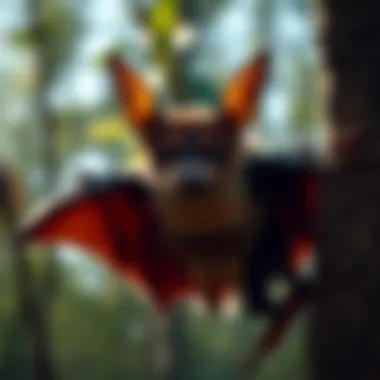
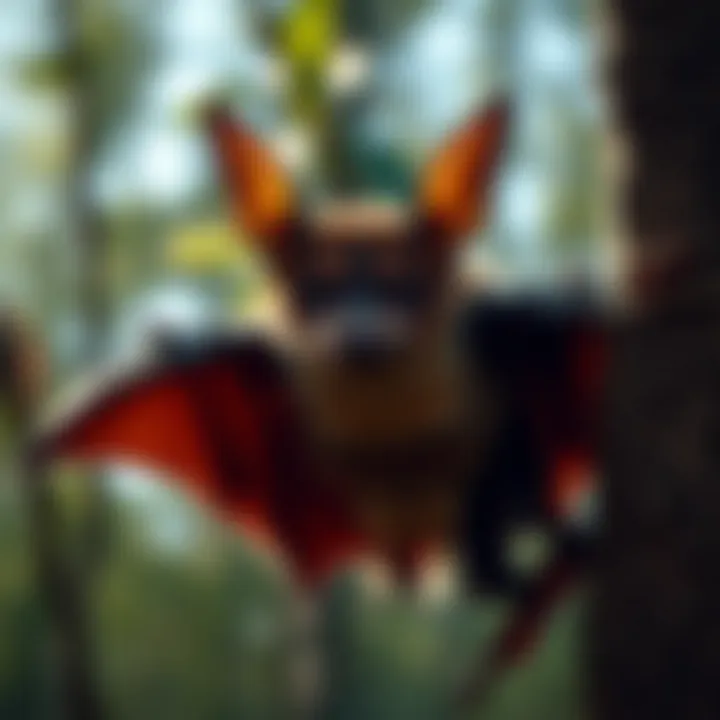
Roosting Locations and Preferences
Roosting locations and preferences play a critical role in bat behavior, as these habits provide safety, thermoregulation, and breeding opportunities. Bats are known to roost in various environments—from caves and hollow trees to man-made structures, adapting to diverse settings. The key characteristic here is the choice of roost, which often reflects environmental needs—access to food, temperature control, and protection from predators are paramount.
The unique feature of roosting preferences is that some bats, such as the common pipistrelle (Pipistrellus pipistrellus), will choose roosts based on seasonal changes, often moving between locations to find what suits them best. This adaptability is advantageous as it maximizes their chances for survival in different environments. However, not all bats are flexible—habitat loss can disrupt these delicate preferences, posing a significant threat to their populations.
Understanding the complex behaviors of bats nuances our perception of their ecological roles and survival strategies. This knowledge can guide conservation efforts that are critical for their survival.
Reproductive Strategies in Bats
Bats are fascinating creatures, exhibiting a rich variety of reproductive strategies that play a pivotal role in their survival and species continuity. Understanding these reproductive schemes is essential because they help explain the population dynamics and social structures within bat communities. The strategies bats employ not only influence their immediate offspring but also have broader implications for their ecological niches and conservation status.
Mating Systems
Monogamous vs. Polygamous Systems
In the world of bats, mating systems can be predominantly categorized into monogamous and polygamous systems. Monogamous relationships are characterized by one male and one female forming a pair bond to mate exclusively. This setup can be beneficial in environments where parental investment is crucial for the offspring's survival, allowing both parents to contribute to nurturing their young.
On the other end of the spectrum, polygamous systems can involve multiple mating partners for either gender. A notable example of this is the case of the Mexican free-tailed bat, which often engages in polyandrous or polygynous behavior depending on the season and availability of mates. This flexibility allows quick adaptation to environmental changes and helps ensure genetic diversity.
One significant characteristic of these systems is how they affect reproductive success. Monogamous systems tend to produce more blended genetic lines, offering stability within local populations. In contrast, polygamous systems may enhance evolutionary fitness through increased genetic variation, vital for the resilience of bat populations against diseases and changing ecosystems.
"The choice of mating system affects genetic diversity and population health, essential for the longevity of bat species."
Key Characteristics of Mating Systems
- Monogamous: Focus on mutual care, stability in habitat, reduced competition for mates.
- Polygamous: Hinges on mating variety, increased genetic flow, adaptability to ecological shifts.
In summary, the decision of bats to engage in either monogamous or polygamous systems is a complex interplay of ecological pressures and behavioral traits. These mating choices represent effective strategies to maximize reproductive success, ensuring that the next generation thrives in varying environments.
Gestation and Parental Care
Bats typically have unique gestational periods depending on the species, ranging from a mere few weeks to several months. The length of gestation can be influenced by environmental conditions or the specific mating strategy employed by the species. For instance, the little brown bat has a gestation period of about 50 to 60 days, after which a single pup is born. This relatively short gestation allows more rapid population turnover, vital for maintaining numbers in fluctuating ecosystems.
Parental care in bats varies significantly, but many species demonstrate a high level of investment in their young. Maternity colonies, where females gather to give birth and care for their pups, are quite common. In these scenarios, mothers will nurse their young, providing the vital nutrients needed for growth and survival.
In some bat species, like the Egyptian fruit bat, communal care is also observed, where other females in the colony assist in nurturing the pups. This cooperative breeding behavior can enhance the survival rate of the young.
The balance of gestation length and quality parental care establishes a strong foundation for the long-term survival of bats. Their varied reproductive strategies reflect not only their adaptability but also the crucial ways they maintain ecosystem health through their presence.
For further reading on bat reproduction and behavior, you may check these resources: Wikipedia - Bats, Britannica - Bat Reproductive Strategies.
Threats to Bat Populations
Bats, those intriguing nocturnal creatures, face numerous threats that put their populations at risk. Understanding these dangers is crucial not only for the survival of bats but also for the overall health of our ecosystems. As key players in pollination and pest control, the decline of bat numbers can lead to cascading effects in their environments. From loss of habitat to deadly diseases, each aspect contributes to the ongoing struggle for survival among various bat species.
Habitat Loss and Fragmentation
Habitat loss is one of the most pressing threats to bat populations. Urbanization, deforestation, and agricultural expansion have resulted in significant changes to landscapes that once provided sanctuary for these mammals. As old roosting sites are demolished to make way for development, bats find themselves squeezed into fragmented areas. This can lead to:
- Isolated populations: When bat groups become separated, genetic diversity diminishes, making them more vulnerable to extinction.
- Increased competition for resources: With fewer roosting sites and foraging areas, bats may struggle to find enough food and safe spaces to thrive.
- Disruption of migratory patterns: Some bat species migrate to exploit seasonal resources. Habitat destruction can interfere with these routes, resulting in lower survival rates.
Diseases Affecting Bats
The presence of diseases significantly impacts bat populations, with several pathogens responsible for devastating declines across various species. Understanding these diseases and their implications is imperative for conservation efforts.
Widespread Fungal Infections
Widespread fungal infections, particularly those caused by Pseudogymnoascus destructans, have wreaked havoc among bat colonies. This pathogen is notorious for causing white-nose syndrome, a disease characterized by white fungal growth on bats' muzzles and wings. Key characteristics include:
- High mortality rates: Infected bats often experience severe physiological stress leading to high fatalities during hibernation.
- Transmission dynamics: The fungus can spread rapidly in bat colonies, making outbreaks difficult to control.
- Seasonal patterns: The disease manifests predominantly during the hibernation months when bats are most vulnerable.
The significance of addressing widespread fungal infections lies in the potential to develop better management strategies that could protect susceptible species and their habitats.
Impact of White-Nose Syndrome
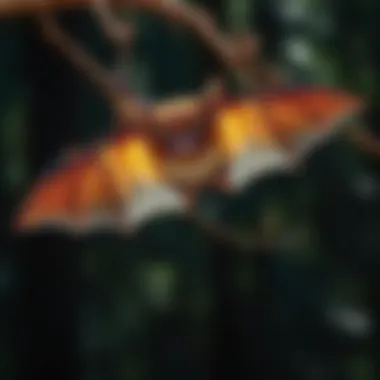
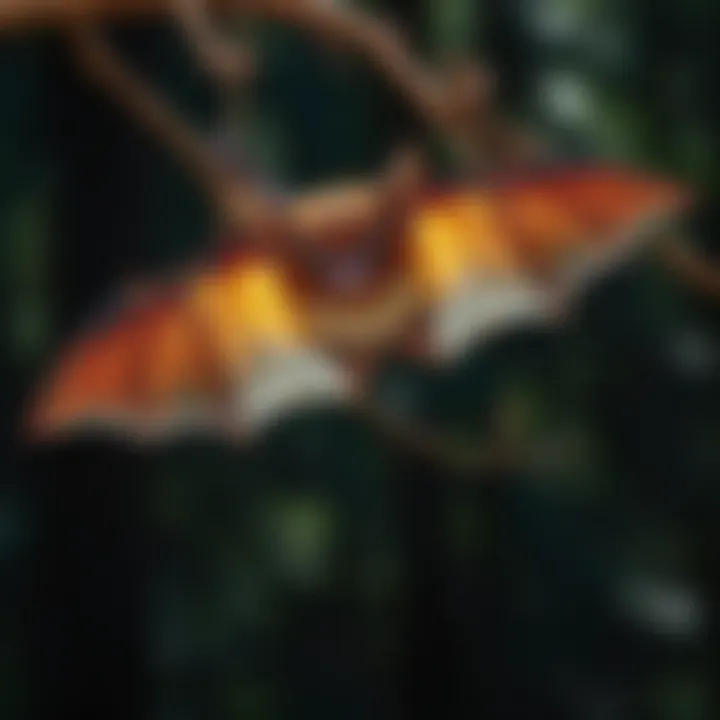
White-nose syndrome stands out as one of the most critical threats faced by bats today. Its effects can be profound, altering not only bat populations but also disrupting entire ecosystems. Some notable points:
- Dramatic declines: Certain bat populations in North America have experienced population declines of up to 90% due to this condition.
- Ecosystem balance: With fewer bats, there may be a surge in insect populations, potentially affecting agriculture and human health.
- Research and education: There is growing effort in educating the public and researchers about this syndrome to mitigate its impact.
Addressing the threat of white-nose syndrome through research and conservation efforts is critical if we aim to stabilize bat populations and maintain ecological equilibrium.
In summary, the various threats bats face today—from habitat loss to diseases like white-nose syndrome—underscore a critical need for coordinated conservation efforts. As bats are essential to the functioning of many ecosystems, protecting them not only benefits the species itself but also the broader environmental health that relies on their existence. For more in-depth information on protecting bat populations, visit Centers for Disease Control and Prevention or U.S. Fish & Wildlife Service.
Conservation Efforts for Bats
Conservation effors for bats are crucial as bat populations face numerous threats in the modern world. These efforts not only aim to protect individual species but also to maintain the balance within the ecosystems that depend on bats. Given their role in pest control, pollination, and seed dispersal, protecting bats directly contributes to the health of various natural habitats. The decline of bat populations could lead to an increase in insect pests and disruptions in plant reproduction, which ultimately affects human agriculture and forestry.
Legislative Protections
Legislative protections play a key role in the conservation of bat species. Various countries have enacted laws aimed at protecting these mammals from habitat destruction, hunting, and disturbance. In the United States, for example, provisions under the Endangered Species Act provide frameworks for the protection of listed bat species like the Indiana bat and the Little brown bat. These laws are instrumental in regulating land use in critical habitats, thus minimizing human impact on bat roosting sites.
It is imperative for regulations to be adaptive, taking into account ongoing research about bat behaviors and needs. Furthermore, collaboration between lawmakers and wildlife experts can lead to more robust measures that protect bats at a national and local level.
"Effective legislative action can create safe havens for bat populations, ensuring their survival and preserving the ecological functions they serve."
Public Awareness and Educational Programs
Public awareness and educational programs about bats are pivotal for fostering a community of stewards for wildlife conservation. Engaging citizens through outreach can reshape misconceptions about bats, often seen as pests or harbingers of disease. Such initiatives not only highlight the benefits bats provide but also encourage locals to take part in their protection.
Community Involvement
Community involvement is a cornerstone of these educational programs. By bringing together diverse groups, including schools, conservation organizations, and local businesses, the message about the importance of bats can be amplified. Workshops, informational sessions, and bat watching events’ encourages participation and helps deepen the understanding of local ecosystems.
The unique characteristic of community involvement lies in its ability to create a grassroots movement focused on conservation. This not only nurtures local pride in bat species but also may lead to tangible actions, such as habitat restoration initiatives or the establishment of bat houses. On the downside, sustaining community engagement can be challenging, as it requires ongoing effort to maintain interest and effectively disseminate information.
Research Collaboration
Research collaboration between academic institutions and conservation groups enhances the overall understanding of bat ecology. By pooling resources and expertise, these collaborations provide deeper insights into bat behavior, migratory patterns, and health statuses. This collaborative environment encourages innovation in research methods and conservation strategies, proving to be beneficial for both bats and researchers alike.
A salient aspect of research collaboration is the shared knowledge gained, which informs best practices for bat conservation. The integrating knowledge assists in shaping effective legislative protections as well. However, outcomes can be slow to manifest, as studies take time and funding can often be a limiting factor. Still, the advantages of collaboration often outweigh the drawbacks, as it builds a foundation for long-term sustainability in conservation efforts.
Specific Bat Species Overview
Understanding specific bat species goes beyond mere cataloging; it's a window into the ecological interplay that these creatures maintain within their environments. By honing in on particular examples, we can appreciate not just their individual traits, but the collective contribution they make to ecosystem health. This section highlights the significance of selected species, illustrating how their unique characteristics reflect broader ecological patterns and adaptations.
Common Pipistrelle
Habitat and Distribution
The Common Pipistrelle, a small bat often overshadowed by its more exotic relatives, is quite widespread across Europe and parts of Asia. This widespread distribution, underpinned by its adaptability to various habitats from woodlands to urban areas, showcases its resilience and flexibility. Notably, these bats prefer to roost in buildings and trees, making them more accessible for observation compared to other specialists that might dwell in more secluded areas.
The adaptability of the Common Pipistrelle to urban settings is particularly advantageous, as urban environments often afford food plentiful in the form of insects. However, this also means they face pressures from urbanization, including habitat fragmentation. As they thrive in human-altered landscapes, it raises questions about their long-term viability in rapidly changing environments.
Ecological Role
The role of the Common Pipistrelle in the ecosystem is not to be taken lightly. This small bat is an insectivorous powerhouse, consuming upwards of 3,000 insects in a single night during peak summer months. Its diet predominantly consists of midges and other small flying insects, acting as a natural pest control agent, which is immensely beneficial for agricultural communities.
Furthermore, their hunting habits promote a balance in insect populations. This characteristic of keeping insect numbers manageable indirectly supports various crops and gardens. Yet, the reliance on connections to wetlands and other water bodies for food means that any changes in these habitats could seriously impact their numbers.
Mexican Free-Tailed Bat
Behavioral Characteristics
The Mexican Free-Tailed Bat is renowned for its remarkable flying abilities and social hierarchy. Often found dwelling in large colonies, sometimes numbering in the millions, these bats exhibit social behaviors that are fascinating and complex. Their ability to fly at incredible speeds—as much as 99 miles per hour—also sets them apart in the chiropteran world, making them not only agile hunters but also effective fliers in avoiding predators.
These behavioral traits contribute to their survival strategy in various ways. They tend to congregate in large roosts, which offer protection from predators and create a dynamic where these bats interact socially. Adjusting to their environment, they often switch roosts based on environmental stimuli, showcasing adaptable behavioral patterns that can be viewed as a response to ecological pressures.
Population Dynamics
Population dynamics of the Mexican Free-Tailed Bat reflect broader ecological trends. These bats can reproduce quickly, giving birth to single pups each spring. Understanding their population structure helps ecologists monitor trends related to food availability and habitat suitability. The social structure of their colonies influences reproductive success and survival rates, highlighting the importance of social interactions in wildlife populations.
Their population changes can also serve as indicators of environmental health. As insectivorous bats, their numbers often correlate with insect population health, making them important bellwethers for outdoor ecosystems. Yet fluctuations due to habitat loss or climate variations can have ripple effects, showcasing the need for targeted conservation efforts.
"The delicate balance of ecosystems can often depend on a single species’ fortunes, making specific bat studies crucial for understanding larger environmental shifts."
Through these focused examinations, it's clear that understanding the specific traits of bat species like the Common Pipistrelle and the Mexican Free-Tailed Bat provides insight into the broader ecological contexts in which they exist. This approach serves as a foundation for appreciating the importance of conserving not just the bats themselves, but the environments they inhabit.







